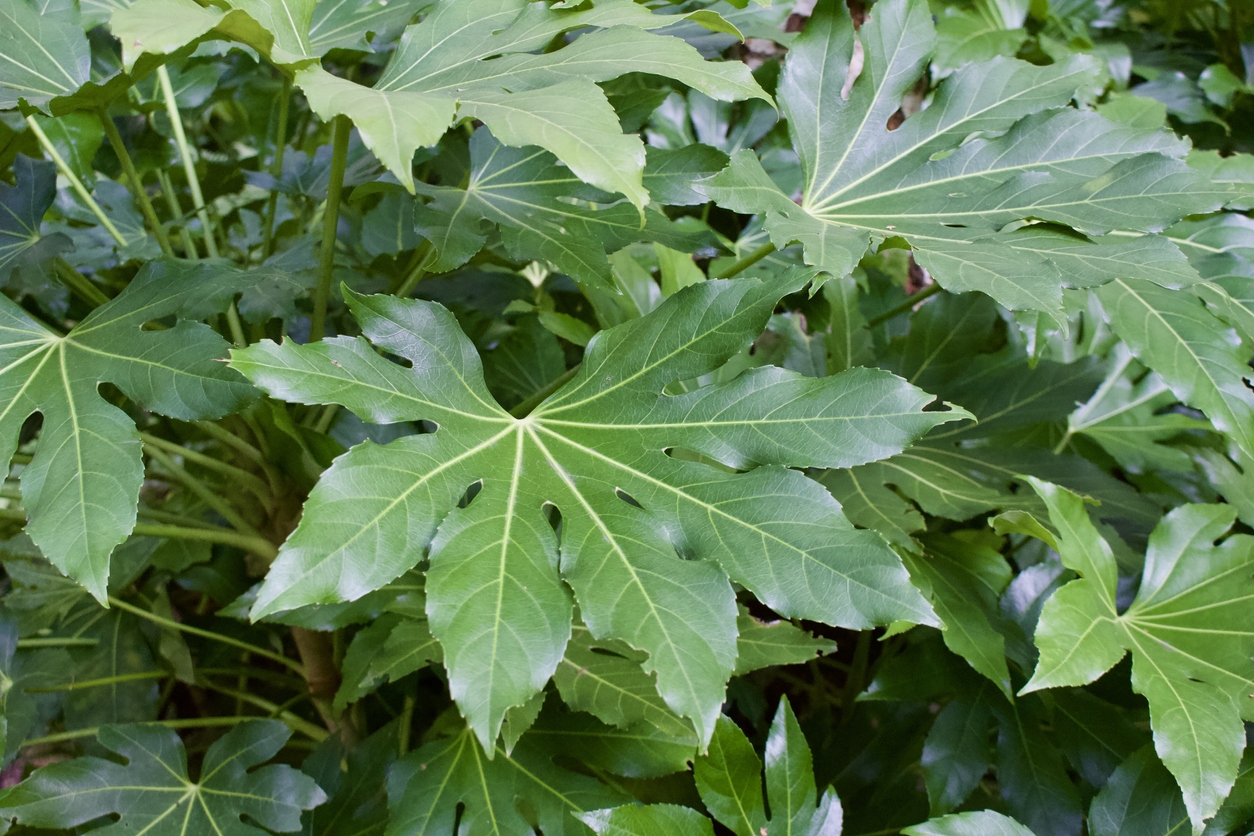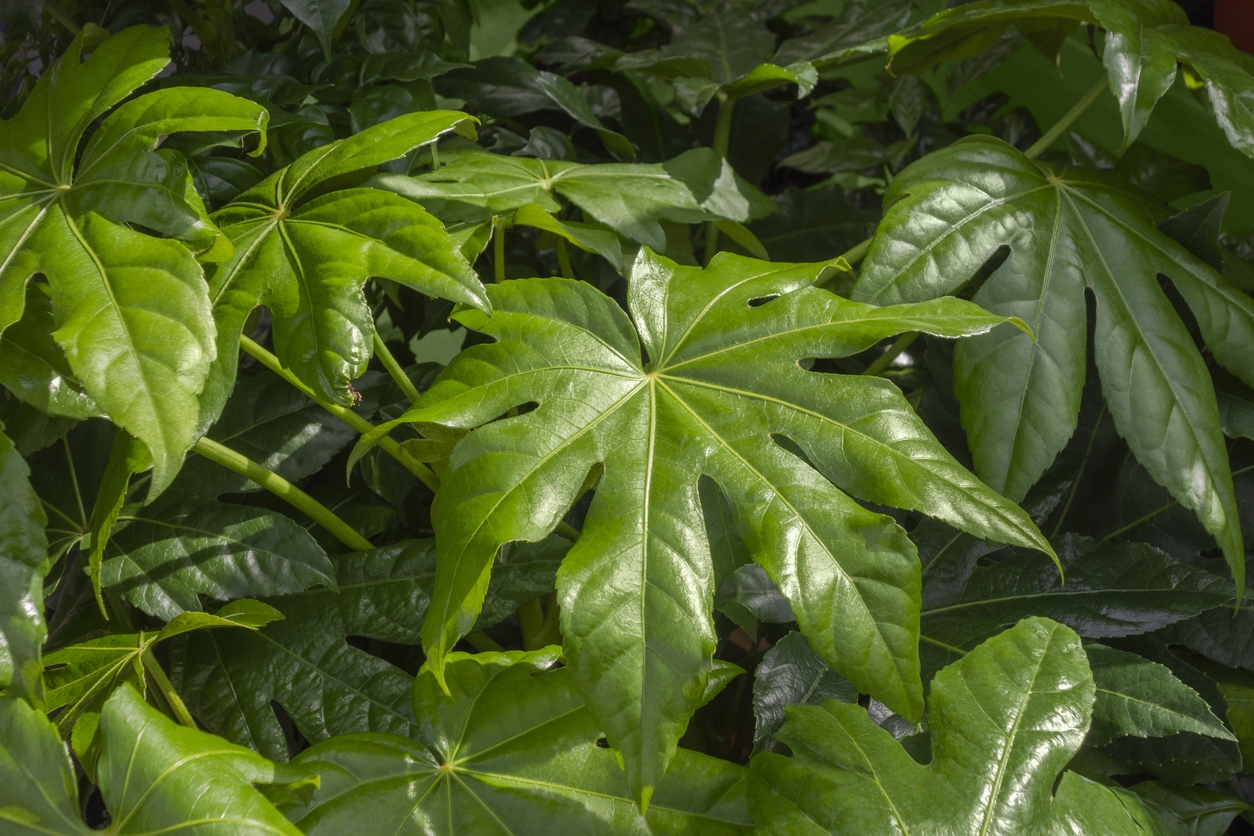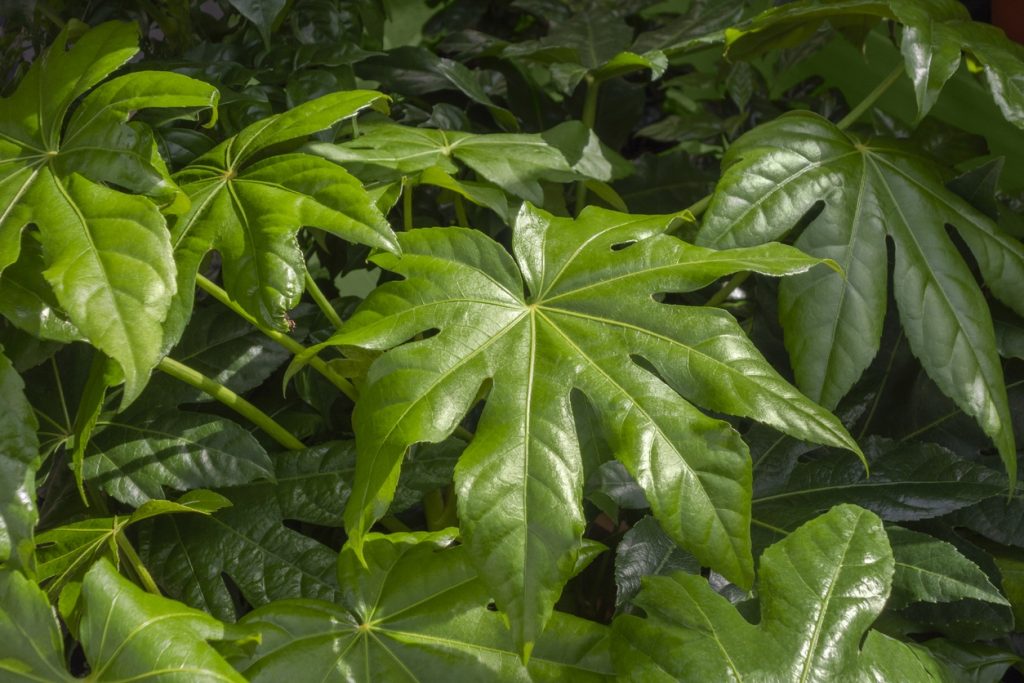Japanese Aralia Care – How To Grow Fatsia Japonica Indoors
Japanese Arlia is one of those landscaping shrubs that work well both in gardens and lawns as well as in open areas. Once it establishes somewhere it spreads out using suckers and seeds to claim as much available space as possible.
But that doesn’t make it an invasive plant. Far from it. With the right care and maintenance, you can keep your single brush looking its best and prevent it from multiplying and self-seeding. And thanks to its high adaptability and tropical appearance, Japanese Arlia has become the ornamental plant of choice for gardens large and small. Just don’t let its sticky sap get on your skin as it might cause contact dermatitis.
Japanese Aralia at a Glance
A native of Japan and Korea, Japanese Arlia (Fatsia japonica) is known by many other names including paper plant, false castor oil, and spider’s web among others. The mature shrub can reach 5 feet tall and the same in width. And with its fast growth rate of almost one foot a year, it won’t take long to reach maturity.
As an adaptable plant, it grows well in zones 7 to 9. The evergreen shrub has quite ornamental leaves that average about 14 inches wide. Each leaf has between 7 to 9 lobes and is dark green with a glossy finish. Although the leaves of some cultivars are variegated.
By the time the Japanese aralia reaches its full height, it acquires a round shape thanks to the many stems it keeps adding every year. When pruning, you can trim off these stems to keep the shrub small and compact. Some people keep one stem and regularly remove any lateral stems and offshoots. This can be useful if you don’t have much space for the aralia.
If you have a shady spot in your garden that you’d like to turn into a tropical corner, plant one or two aralias and let their lush green foliage bring a new life to the garden
Japanese Aralia Varieties
Before you purchase the Japanese aralia seeds or buying the sapling from the local nursery, you need to know which variety and cultivar work best for you. With the many species and hybrids that the fatsia japonica come in, you’re guaranteed to find one or two you can grow in your garden. Here are some popular varieties.
- Spider’s Web: The leaves of this variety are its main claim to fame. Unlike the other species with their dark green leaves, this one has variegated leaves where the green is outlined by white around the edges. This explains the name Spider Web. It can reach 8 feet tall if left unattended and has white flowers which bloom in November and December. You can also grow it in a container and prune it regularly to manage its size.
- Moseri: A small variety by aralia standards. But for its small height, it spreads out and makes up for it with its dense foliage. A fast-growing shrub, this variety requires constant pruning and is not suitable for potting. The large white flowers appear in the fall and continue in bloom all the way to mid-winter. If the flowers get pollinated, they will produce blackberries in February.
- Annelise: The multi-colored leaves give this shrub its unique look. On average the leaves have splashes of yellow, emerald, and green all over them. More shade-tolerant, this shrub grows to about 10 feet high and doesn’t require much care from you. But its size makes it suitable only for outdoor planting.
- Variegata: Another variety that seems to have it all. Beautiful foliage, bright white flowers, and blackberries to boot. A shade-loving shrub, you can grow it both indoors and outdoors. With the right care and maintenance, you can grow it in a planter and keep it as a houseplant. The green leaves with the cream edges fit in every setting.
How to Grow Japanese Aralia
With Japanese aralia, you can take the easy way and start the shrub from seeds. In fact, that’s the recommended way of starting this showy and dramatic shrub. The seeds have a high success rate of germination although they need constant moisture in the soil and stable temperatures to germinate. You can also propagate them from suckers but that would require you have access to a mature plant of the specific variety or cultivar you want. Here’s how to start Japanese aralia from seeds in easy steps.
- You can either get the seeds from a reputable online source or harvest the ripe blackberries of a Japanese aralia to extract seeds from them. If you buy the seeds online, make sure they are fresh.
- To extract seeds from ripe berries, place the berries in a jar full of water and let them soak overnight. By the next day, you’ll have a jar full of dissolved berry flesh and seeds. Strain the mesh to extract the seeds. Y
- Prepare a tray and fill it with equal parts coarse sand, compost, and soil.
- Sow one seed in every cell at a depth of one inch. Cover it with soil and water it lightly to get the potting mix moist.
- Place a heat mat under the tray and set the temperature to 80 degrees Fahrenheit.
- Cover the tray with a plastic sheet to maintain the moisture of the soil. Keep the tray near a window that gets between 6 to 8 hours of sunlight a day.
- Don’t let the soil dry out while the seeds are germinating. Sprinkle the tray regularly about once every couple of days to keep it moist.
- It will take the seeds anything from two to four weeks to germinate.
- Once you see sprouts emerging out of the soil, remove the plastic wrap but keep watering the tray as before.
- When the seedling reaches 3 inches high, transport each one to its own pot filled with the same potting mix.
- Once the soil temperature outside reaches 70 degrees Fahrenheit, move the saplings to their permanent place in the garden.
Japanese Aralia Care
With their adaptability and meaty leaves, Japanese aralia doesn’t need much care once they establish in the soil. The only catch is their fast growth rate. If you plant them indoors then you’ll have to prune them regularly to keep them tame and under control.
Soil
The Japanese aralia will grow in just about any soil you plant it in. Even clay and hard soil that nothing grows in cannot keep the aralia from spreading and multiplying. It only draws the line at drainage. If the soil gets waterlogged easily, the shrubs will not grow well. So amend your clay soil and mix in a generous portion of coarse sand and organic materials to loosen up the texture of the soil and improve drainage. As for soil pH, it should be around neutral to slightly acidic which is common for most plants. Check the pH level and bring it up or down to between 6.0 to 6.8 at most.
Light
One of the biggest advantages of growing Japanese aralia plants is that they do well both in partial as well as full shade. So don’t pick a spot in the garden that gets the full sun or place the potted plant near a window facing the south or west. Too much direct exposure to the sun causes the leaves to lose their glossy and dark green colors and become bleached. It’s OK to allow the plant to get the morning sun as long as it’s filtered either through the leaves of another tree or a lace curtain for indoor plants.
Water
Japanese aralia loves the soil to be constantly moist. It has a low tolerance for drought and the plant will let you know quickly when the soil gets dry. The leaves will become yellow and droop while the stems wilt and bend under the weight of the leaves. So water the plant regularly but keep it shallow. If you’re using a potting mix, then soak the container until the water flows out of the drainage holes at the bottom. Outside the growing seasons (spring and summer) hold back on watering and reduce the amount of water and regularity by up to half.
Fertilizer
Although not a heavy feeder, Japanese aralia still benefits from regular fertilizing. You don’t have to go overboard with your fertilizer though. Any mild and diluted liquid fertilizer or organic compost tea will give you good results. Start your fertilizing from the early spring and continue throughout the summer at intervals of once every couple of weeks. You won’t need to fertilize the plant during the fall and winter.
Repotting
As with most perennials, if you’re growing Japanese aralia in a pot, then repotting will become a regular maintenance task. The plant will let you know when it needs to be repotted. You might notice the roots growing out of the drainage holes, or the plant looks stressed. On average you’ll need to repot your plant once a year at least. Some varieties with exceptionally high growth rates might be repotted twice a year. Try to move between pots in small increments. Moving the aralia to a pot double the old pot’s size might distress the plant and cause a shock. It will also make repotting it later a problem since the roots will grow at a faster rate with all the space available for them. Always water the potted plant before and after repotting. This helps you ease it out of the pot and reduces the shock of transplanting for the aralia.
Pests and Diseases
Mealybugs and aphids are the two main pests to watch out for when it comes to caring for Japanese aralia. Aphids especially are tiny insects that hide under the broad leaves of the aralia and feed on the sap of the new leaves and shoots. Don’t try to wash them off the aralia with a hose or a bucket of water since that would open the door for fungal infections. Instead, you should spray them with neem oil to get rid of them before they become a serious infestation.
Mealybugs also feed on the sap of the leaves but they attack mature and fully grown leaves and branches. They also leave behind honeydew, a sticky substance that is fertile ground for bacteria and spores especially the ones that cause sooty mold.
You can also use neem oil against mealybugs or rub the branches and leaves with a swab soaked in rubbing alcohol.



